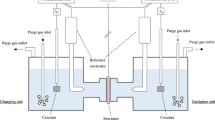Abstract
Strengthening of palladium using hydrogen-induced transformation hardening (“hydrogen phase naklep” (HPN)) in the course of the reverse β → α hydride phase transformation in palladium-hydrogen alloys has been studied. It has been shown that the degree of HPN is mainly determined by the difference of the specific volumes of the transforming phases. As the transformation temperature decreases and the difference of the specific volumes of the transforming phases increases, the degree of strengthening of palladium during HPN systematically increases and its plasticity decreases, which is accompanied by an increase in the dislocation density and magnitude of microdistortions and by a decrease in the dimensions of the mosaic blocks.
Similar content being viewed by others
References
V. A. Goltsov, “The Phenomenon of Controllable Hydrogen Phase Naklep and Prospects for Its Use in Metal Science and Engineering,” Mater. Sci. Eng. 49(2), 109–125 (1981).
V. A. Gol’tsov, “Phenomena Caused by Hydrogen and Hydrogen-Induced Transformations,” in Hydrogen Interaction with Metals, Ed. by A. P. Zakharov (Nauka, Moscow, 1987), Chapter 9, pp. 264–292 [in Russian].
V. A. Goltsov, “Fundamentals of Hydrogen Treatment of Materials,” in Progress in Hydrogen Treatment of Materials, Ed. by V. A. Goltsov (Kassiopeya, Donetsk-Coral Gables, Fla, 2001), pp. 3–36.
V. A. Goltsov and N. N. Vlasenko, “The Hydrogen Phase Naklep Phenomenon and Its Use in Hydrogen Treatment of Metallic Materials,” in Progress in Hydrogen Treatment of Materials, Ed. by V. A. Goltsov (Kassiopeya, Donetsk-Coral Gables, Fla, 2001), pp. 203–230.
V. I. Zaitsev and V. G. Gorbach, “Changes in the Structure and Strength Properties during Heating of an Alloy Deformed in the Martensite State,” Fiz. Met. Metalloved. 17(5), 714–718 (1964).
E. A. Izmailov and V. G. Gorbach, “X-ray Diffraction Microscopic Study of the Structure of Austenite in an Fe-Ni Alloy upon Forward and Reverse Martensitic Transformation,” Fiz. Met. Metalloved. 20(1), 114–119 (1965).
V. I. Zaitsev and V. G. Gorbach, “Effect of the Initial Structure of Martensite on the Austenite Strengthening during Transformation-Induced Phase Hardening,” Fiz. Met. Metalloved. 20(4), 608–613 (1965).
V. G. Gorbach, E. A. Izmailov, and K. A. Malyshev, “Strengthening of Aging Fe-Ni-Ti Alloys in the Process of Forward and Reverse γ → α → γ Transformations,” Fiz. Met. Metalloved. 20(5), 741–748 (1965).
K. A. Malyshev, V. V. Sagaradze, I. P. Sorokin, et al., Transformation-Induced Hardening of Austenitic Iron-Nickel-Based Alloys (Nauka, Moscow, 1982) [in Russian].
V. V. Sagaradze and A. I. Uvarov, Strengthening Austenitic Steels, Ed. by V. D. Sadovskii (Nauka, Moscow, 1989) [in Russian].
G. I. Zhirov, V. A. Gol’tsov, and D. A. Glyakov, “Mechanical Properties of Palladium Hydride after Annealing and Hydrogen-Induced Transformation Hardening,” Fiz. Met. Metalloved. 97(1), 113–120 (2004) [Phys. Met. Metallogr. 97, 104–110 (2004)].
M. V. Gol’tsova, Yu. A. Artemenko, and V. I. Zaitsev, “Kinetic Peculiarities of Degassing and β → α Hydride Transformation in a Thermodynamically Open Palladium-Hydrogen System,” Fiz. Met. Metalloved. 84(4), 140–143 (1997) [Phys. Met. Metallogr. 84, 418–420 (1997)].
Ya. S. Umanskii, Yu. A. Skakov, A. N. Ivanov, et al., Crystallography, X-ray Diffraction, and Electron Microscopy (Metallurgiya, Moscow, 1982) [in Russian].
S. S. Gorelik, Yu. A. Skakov, and L. N. Rastorguev, X-ray Diffraction and Electron-Microscopic Analysis (MISIS, Moscow, 1994) [in Russian].
E. Wicke and H. Brodowsky, “Hydrogen in Palladium and Palladium Alloys,” in Hydrogen in Metals II: Application-Oriented Properties, Ed. by G. Alefeld and J. Völkl (Springer, Berlin, 1978; Mir, Moscow, 1981).
M. V. Gol’tsova and G. I. Zhirov, “Grain Displacement in Palladium and PdHx Alloys upon Hydrogen Shocks,” Fiz. Met. Metalloved. 94(3), 1–6 (2002) [Phys. Met. Metallogr. 94, 276–281 (2002)].
M. V. Goltsova, Yu. A. Artemenko, and G. I. Zhirov, “Hydride Transformations: Nature, Kinetics, Morphology,” in Progress in Hydrogen Treatment of Materials, Ed. by V. A. Goltsov (Kassiopeya, Donetsk-Coral Gables, Fla, 2001), pp. 161–184.
Author information
Authors and Affiliations
Additional information
Original Russian Text © G.I. Zhirov, V.A. Gol’tsov, G.E. Shatalova, D.A. Glyakov, 2006, published in Fizika Metallov i Metallovedenie, 2006, Vol. 101, No. 1, pp. 103–112.
The author is also known by the name Goltsov. The name used here is a transliteration under the BSI / ANSI scheme adopted by this journal.—Ed.
Rights and permissions
About this article
Cite this article
Zhirov, G.I., Gol’tsov, V.A., Shatalova, G.E. et al. Mechanical properties and fine structure of annealed and HPN-treated palladium. Phys. Metals Metallogr. 101, 93–102 (2006). https://doi.org/10.1134/S0031918X06010133
Received:
Accepted:
Issue Date:
DOI: https://doi.org/10.1134/S0031918X06010133



